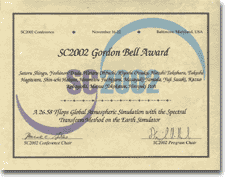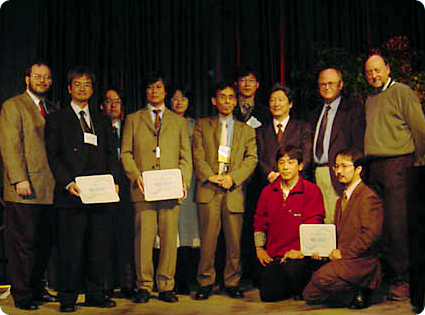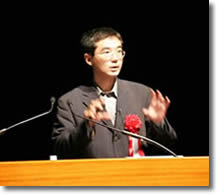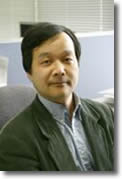Awards
The Gordon Bell Award was founded by Mr. Gordon Bell in 1987 for the advance of parallel computing technology, and is managed by the IEEE Computer Society. This award is given for the best performance in several categories related to hardware and software progress.
The simulation, 15.2Tflops, of a dynamo and geomagnetic fields by the Earth Simulator
|
November 2004 The Gordon Bell Award for Peak Performance
|
|
- Coauthor
- Masanori Kameyama, Satoru Fujiwara, Masaki Yoshida, Mamoru Hyoudou, Yoshinori Tsuda.
In the field of Solid Earth by using the Earth Simulator, we again won ‘The Gordon Bell Award for peak performance’ from the previous year.
It was awarded for the High-speed simulation of dynamo and geomagnetic fields in order to resolve the derivation of the geomagnetic field.
The compass always points north direction is because the earth itself creates geomagnetic field. Inside of the earth, it has been considered that there is a region called “core” with the radius of about 3,500km and its constituent of iron has the convective motion to produce the geomagnetic field.
Developing a new simulation code to resolve the Hydromagnetics equation faster and more effectively on the newly designed called‘Yin-Yang Grid', we optimized it to make the most of the characteristics of the Earth Simulator.
As a result, we have proven that the code is performable for simulation of dynamo and geomagnetic fields reproducing the characteristics of the geomagnetic field by high speed and high efficiency.
JAMSTEC has been awarded this award every year since the completion of the Earth Simulator in 2002.
"Modeling of global seismic wave propagation on the Earth Simulator"
|
November 2003 The Gordon Bell Award for Peak Performance (5Tflops)
|
|
Awarded subject is the seismic wave reproduction simulation of the Earthquake occurred in Alaska U.S.A. in November 3, 2002, which was measured magnitude of 7.9.
Dividing the globe into 5.4 billions parts with 2.9km squares, they succeeded in simulation of the seismic wave propagation which shows the complexion go through the various areas on the glove.
Using 640 processor nodes, totally 1,944 processors, of the Earth Simulator, they have archived the sustained performance of 5 Tera flops.
5 Tera flops indicates the calculation performance of 5 trillion equations per second.
November 2002
Three groups of the Earth Simulator Center were awarded for the following researches in these fields;
A 26.58 Tflops Global Atmospheric Simulation with the Spectral Transform Method on the Earth SimulatorThe Gordon Bell Award for Peak Performance (26.58Tflops)
14.9 Tflops Three-dimensional Fluid Simulation for Fusion Science with HPF on the Earth SimulatorThe Gordon Bell Award for Language (special category) (14.9Tflops)
16.4-Tflops Direct Numerical Simulation of Turbulence by a Fourier Spectral Method on the Earth SimulatorThe Gordon Bell Award for special accomplishment (16.4Tflops)



